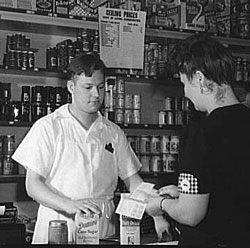|



Retailing and Conveniences
 |
 |
During
the early 20th century, the United States became the first
modern consumer society—a society whose prosperity depended
on providing goods to a mass market. From the introduction
of Henry Ford´s Model T ("so low in price that
no man making a good salary will be unable to own one")
and the innovations in selling that arrived with the department
store (window displays, self service, the installment plan)
to the development of new arenas for spending (amusement parks,
penny arcades, baseball parks, and dance halls), Americans
embraced the new culture of consumerism. By
the end of the 20th century, consumerism had triumphed over
all competitors around the world: socialist, fascist, Communist. |
Sugar
rationing.
The war has brought new purchasing procedures to American
consumers. The ration book assures all Americans just distribution
of the available sugar on the market. Note the "ceiling
prices" posted on the grocery shelves, a guarantee
to consumers that prices will not exceed those of March
this year.
Albert Freeman, Photographer, July 1946
Library of Congress |
| |
|
Not
coincidentally, the United States has bred consumerism’s
harshest critics, from Thorsten Veblen to Ralph Nader.
Key
Questions:
1.
Trace the rise of consumerism in the United States.
2.
What conveniences have appealed to Americans at different times?
3.
What factors explain the triumph of consumerism in the United
States?
4.
What was the impact of the Great Depression of the 1930s on
consumerism?
5.
Why have consumerism’s critics’ condemnation of
materialism, over-commercialization, and environmental degradation
failed to have much influence on the American public?
6.
Trace the growth of “niche” marketing.
|
